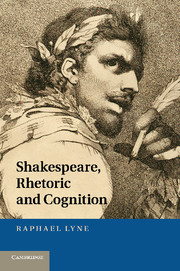Book contents
- Frontmatter
- Contents
- Acknowledgments
- Chapter 1 Introduction: ‘pity, like a naked new-born babe’
- Chapter 2 Metaphor and synecdoche in cognition
- Chapter 3 The drift towards cognition in rhetorical manuals
- Chapter 4 A Midsummer Night’s Dream
- Chapter 5 Cymbeline
- Chapter 6 Othello
- Chapter 7 The Sonnets
- Conclusion
- Notes
- Bibliography
- Index
Chapter 3 - The drift towards cognition in rhetorical manuals
Published online by Cambridge University Press: 07 September 2011
- Frontmatter
- Contents
- Acknowledgments
- Chapter 1 Introduction: ‘pity, like a naked new-born babe’
- Chapter 2 Metaphor and synecdoche in cognition
- Chapter 3 The drift towards cognition in rhetorical manuals
- Chapter 4 A Midsummer Night’s Dream
- Chapter 5 Cymbeline
- Chapter 6 Othello
- Chapter 7 The Sonnets
- Conclusion
- Notes
- Bibliography
- Index
Summary
This chapter undertakes an alternative history of rhetorical manuals with renaissance England as culminating point and principal focus. The goal is to tune in to incipient hints that rhetoricians in Shakespeare’s cultural milieu are perceiving, or claiming, that their discipline patterns thoughts as well as the means of communicating them. Rhetorical treatises and manuals have much at stake in implicitly or explicitly recognising that their tropes might not just be adorning their material, but may in fact be expressions of the genesis of the thoughts behind that material. They stand to gain in that their discipline might be elevated by the grandeur of such a claim, but they stand to lose in the potential dilution of their already compelling purpose. The word ‘behind’ above – thoughts behind words – is a metaphor, a way of presenting a complicated tangle, just as a chronology – thoughts before words – would be. This vexed question in the philosophy of language, as has been said, will not be answered in the discussion that follows. It is not really broached by the crucial passages, because they do not impinge on the central premises of the treatises involved. They do, however, suggest potential and discoveries beyond their explicit scope – the kind of thing that the flourishing of rhetoric in drama might bring out all the more.
These works have not always been read sympathetically because of a sometimes understandable feeling that they are rather pedantic. As a result, the dynamic nature of the word ‘rhetoric’ is often harnessed in modern scholarship and theory without particular allegiance to the details of the ancient discipline, its rules, its warnings, its categories and subcategories. The point here is of course to respond to these details and the purposes behind them, but also to note that sometimes the impatient or quizzical feelings of modern readers may reveal meaningful problems in the rhetorical tradition. These technicalities terms might sometimes be undervalued because they are taken on what seem to be their own terms. Reading between the lines leads to characteristics and possibilities (in metaphor and synecdoche especially) that can enhance the range of tropes’ activities, giving rhetorically informed close reading a different kind of reach.
- Type
- Chapter
- Information
- Shakespeare, Rhetoric and Cognition , pp. 68 - 99Publisher: Cambridge University PressPrint publication year: 2011

